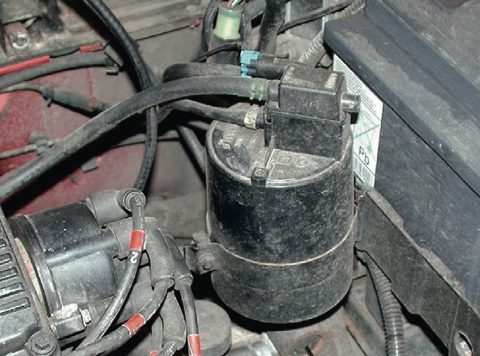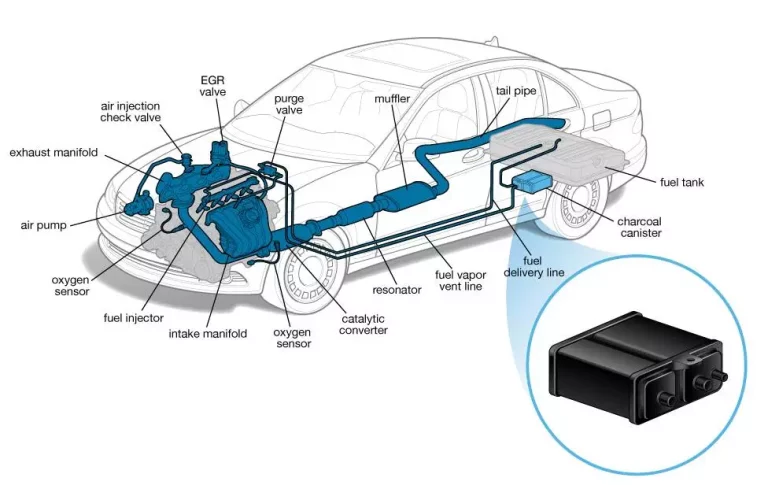What is a Charcoal Canister and How Does it Work?
If you own a modern car, chances are it has a component called a charcoal canister. This device is part of the vehicle’s evaporative emissions control system, which helps to reduce the amount of harmful gases that are released into the atmosphere.
The charcoal canister is a small, cylindrical device that is usually located near the fuel tank. It is filled with activated charcoal, which is a highly porous material that has been treated with chemicals to make it more effective at absorbing volatile organic compounds (VOCs).
VOCs are a type of gas that is produced when gasoline evaporates. They are also produced by a variety of other common chemicals, such as solvents, cleaners, and even some consumer products like air fresheners. When these gases are released into the air, they can contribute to the formation of smog and other forms of air pollution.
The charcoal canister is connected to the fuel tank and the engine’s intake manifold via a series of hoses. As the fuel tank is filled, any excess gasoline vapor is routed through the hoses and into the charcoal canister. The activated charcoal inside the canister absorbs the VOCs, trapping them within its porous structure.
When the engine is running, it creates a vacuum that draws air through the canister and into the intake manifold. This causes the VOCs that are trapped inside the charcoal to be released into the engine, where they are burned along with the fuel. This process helps to prevent the release of harmful gases into the atmosphere.
Over time, the activated charcoal inside the canister becomes saturated with VOCs and loses its effectiveness. When this happens, the canister must be replaced in order to ensure that the vehicle’s emissions control system is working properly.
In addition to the charcoal canister, modern vehicles also typically include other components as part of their evaporative emissions control system, such as a purge valve and a fuel tank pressure sensor. These components work together to help ensure that any excess gasoline vapor is properly captured and burned, reducing the amount of harmful emissions that are released into the air.
In conclusion, the charcoal canister is an important component of a modern vehicle’s emissions control system. By trapping volatile organic compounds that are produced during the fueling process, it helps to reduce air pollution and protect the environment. Regular maintenance of this component is important to ensure that it is working properly and that your vehicle is operating in an environmentally responsible manner.
As I mentioned earlier, the charcoal canister is just one part of a larger system that is designed to capture and burn off harmful gases that are produced during the fueling process. The system works by creating a closed loop between the fuel tank, the engine, and the canister, with a series of hoses and valves that regulate the flow of gases between these components.

When the vehicle is not in use, the charcoal canister absorbs the excess gasoline vapor that is produced as a result of evaporation from the fuel tank. As the engine is started and begins to run, the system’s purge valve opens, allowing the trapped gases to be drawn into the engine where they are burned along with the fuel.
The fuel tank pressure sensor is another important component of the system. This sensor monitors the pressure inside the fuel tank and sends a signal to the vehicle’s onboard computer if the pressure exceeds a certain threshold. This can happen if the fuel cap is not properly tightened or if there is a leak in the system, which could allow harmful gases to escape into the environment.
If the computer detects a problem with the emissions control system, it will typically trigger the vehicle’s “check engine” light and store a diagnostic code in its memory. This code can be read using a diagnostic tool, allowing technicians to identify the specific component that is causing the problem and make the necessary repairs.
It’s worth noting that while the charcoal canister is an effective tool for reducing emissions, it is not a perfect solution. There are still some gases that can escape from the fuel tank and other components of the system, particularly if there is a leak or malfunction. Additionally, the use of ethanol in gasoline has been shown to reduce the effectiveness of charcoal canisters, as ethanol can interfere with the absorption of VOCs by the activated charcoal.
Despite these limitations, however, the use of charcoal canisters and other emissions control technologies has led to significant improvements in air quality over the past several decades. By capturing and burning off harmful gases, these systems help to reduce the amount of pollution that is released into the environment, protecting both human health and the natural world.
Advantages of Charcoal Canisters:
- Reduces Harmful Emissions: The primary advantage of a charcoal canister is that it helps to reduce harmful emissions from a vehicle’s fuel system. By trapping and burning off volatile organic compounds (VOCs), it helps to protect the environment and improve air quality.
- Cost-Effective: Charcoal canisters are relatively inexpensive and easy to install, making them an affordable option for automakers and consumers alike.
- Low Maintenance: Charcoal canisters require little to no maintenance beyond periodic replacement. This makes them a convenient option for drivers who want to reduce their environmental impact without having to perform complex maintenance tasks.
- Widely Available: Charcoal canisters are widely available and can be found at most auto parts stores and service centers. This makes it easy to replace them when necessary.
Disadvantages of Charcoal Canisters:
- Limited Effectiveness: While charcoal canisters are effective at trapping some harmful emissions, they are not able to capture all of the VOCs that are produced by a vehicle’s fuel system. This means that some pollutants may still be released into the environment.
- Ethanol Interference: As I mentioned earlier, the use of ethanol in gasoline can interfere with the effectiveness of charcoal canisters. This means that drivers who use ethanol-blended fuels may not see the same level of emissions reduction as those who use conventional gasoline.
- Malfunction Risk: Like any component of a vehicle, charcoal canisters can malfunction or fail over time. If this happens, the vehicle’s emissions control system may not function properly, leading to increased emissions and potential environmental damage.
- Replacement Cost: While charcoal canisters are relatively inexpensive, they do need to be replaced periodically. The cost of replacement can add up over time, especially for drivers who put a lot of miles on their vehicles.
In summary, charcoal canisters offer a number of advantages when it comes to reducing harmful emissions from a vehicle’s fuel system. However, they do have some limitations and potential disadvantages that should be considered before choosing this type of emissions control system. Ultimately, the decision to use a charcoal canister will depend on a variety of factors, including the driver’s environmental goals, fuel type, and budget.










